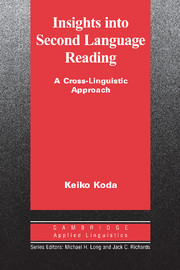Book contents
- Frontmatter
- Contents
- Tables and figures
- Series editors' preface
- Foreword
- Acknowledgments
- I THEORETICAL FOUNDATIONS
- II ESSENTIAL COMPONENTS
- 3 Word recognition
- 4 Vocabulary knowledge
- 5 Intraword awareness and word-knowledge development
- 6 Information integration in sentence processing
- 7 Discourse processing
- 8 Text structure and comprehension
- III LOOKING AT THE WHOLE
- IV THEORY INTO PRACTICE
- References
5 - Intraword awareness and word-knowledge development
Published online by Cambridge University Press: 05 October 2012
- Frontmatter
- Contents
- Tables and figures
- Series editors' preface
- Foreword
- Acknowledgments
- I THEORETICAL FOUNDATIONS
- II ESSENTIAL COMPONENTS
- 3 Word recognition
- 4 Vocabulary knowledge
- 5 Intraword awareness and word-knowledge development
- 6 Information integration in sentence processing
- 7 Discourse processing
- 8 Text structure and comprehension
- III LOOKING AT THE WHOLE
- IV THEORY INTO PRACTICE
- References
Summary
Successful communication relies heavily on accumulated word knowledge. The research on record illuminates several key insights about its development. Word knowledge is formulated in specific contexts. Extracting lexical information from these contexts is in itself an acquired competence. Information extraction, moreover, is greatly expedited by an explicit understanding of a word's internal structure. Consequently, in-depth examinations of such structural awareness can point up the essential competencies underlying word-knowledge accretion through reading. The benefits of these examinations are further supported by the fact that languages differ in the way their elements are represented by the graphic symbols in their writing systems. Knowing that aspects of structural awareness particularly critical to word-knowledge development evolve through cumulative print-processing experience, there is good reason to believe that the nature of the awareness varies across writing systems. It seems reasonable to assume that systematic explorations of these variations should create a window for identifying cross-linguistic differences in the requisite capabilities for lexical learning and processing.
Thus, the primary aim of this chapter is to clarify the ways a writing system's properties relate to the nature of lexical competence in diverse languages. The chapter first reviews the roles of metalinguistic awareness in reading development. Using operational definitions of key concepts as a base, sequential analyses are applied to two typologically contrasting languages, English and Chinese. The intent is to illustrate, with step-by-step descriptions of the analyses, how crosslinguistic differences in the requisite structural awareness and resulting lexical competence can be identified.
- Type
- Chapter
- Information
- Insights into Second Language ReadingA Cross-Linguistic Approach, pp. 71 - 94Publisher: Cambridge University PressPrint publication year: 2005



